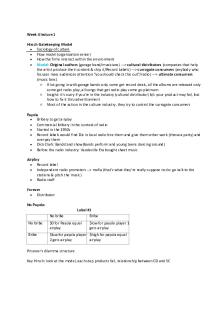EC3012 - Week 4 - Mundell-Fleming Model PDF

| Title | EC3012 - Week 4 - Mundell-Fleming Model |
|---|---|
| Author | Billy Bond |
| Course | International Finance |
| Institution | City University London |
| Pages | 12 |
| File Size | 625.2 KB |
| File Type | |
| Total Downloads | 115 |
| Total Views | 133 |
Summary
Download EC3012 - Week 4 - Mundell-Fleming Model PDF
Description
EC3012 – International Finance – Week 4 Mundell-Fleming Model The Problem of Internal and External Balance 1948-1973: System of fixed exchange rates, major currencies pegged to the US Dollar. In case of disequilibrium, countries devalued or revalued. 1950’s and 1960’s aims of macroeconomic policy: Achieving full employment along with a stable price level (Internal Balance). Implications for balance of payments because of the increase in national income. Increase in employment and Y leads to more imports and the deterioration of the current account. Expenditure changing policies= changes in fiscal and monetary policy aimed to influence the level of aggregate demand in the economy Expenditure switching policies= policies that attempt to change the composition of spending between domestic and foreign goods. Example: devaluation/ revaluation of the exchange rate. Trevor Swann (1955): Swann Diagram, Y- axis: exchange rate in £/$: rise implies depreciation of domestic currency and improved international competitiveness. X- axis: amount of real domestic absorption: C+I+G
IB: Internal balance: full employment and stable prices. Downward sloping: Appreciation reduces exports and increases imports. To maintain full employment, domestic expenditure must rise. To the right of IB there are inflationary pressures as domestic expenditure is greater than what is required to produce full employment at given exchange rate. EB: External balance: equilibrium in the current account. Upward sloping: depreciation of exchange rate will increase exports and reduce imports. Domestic expenditure must increase to offset the decrease in imports. Right of the EB schedule: Domestic expenditure is greater than required for the CA equilibrium. Consequence: deficit. Left of the EB schedule: Domestic expenditure is lower than required for the CA equilibrium. Consequence: surplus. Swann Diagram: Zone 1: a deficit and inflationary pressures Zone 2: a deficit and deflationary pressures Zone 3: a surplus and deflationary pressures Zone 4: a surplus and inflationary pressures 1
The Mundell-Fleming Model Derivation of the IS schedule for Open Economy The IS curve shows various combinations of output and interest where leakages are equal to injections.
S + M =I +G + X Where:
Y −C=S S=S a+sY M =M a +mY dI I =I ( r ) ,...
Similar Free PDFs

Week 4 - week 4 Prac
- 9 Pages

Week 4 - Week 4 notes
- 4 Pages

Week 2 - Heckscher-Ohlin Model
- 5 Pages

4. MODEL TRANSPORTASI-RS
- 14 Pages

Week 4
- 10 Pages

Chater 4 - WEEK 4
- 3 Pages

Contracts Week 4 Day 4
- 2 Pages

Week 4 - Lecture notes 4
- 5 Pages

Week 4 - Chapter 4 Acculturation
- 1 Pages
Popular Institutions
- Tinajero National High School - Annex
- Politeknik Caltex Riau
- Yokohama City University
- SGT University
- University of Al-Qadisiyah
- Divine Word College of Vigan
- Techniek College Rotterdam
- Universidade de Santiago
- Universiti Teknologi MARA Cawangan Johor Kampus Pasir Gudang
- Poltekkes Kemenkes Yogyakarta
- Baguio City National High School
- Colegio san marcos
- preparatoria uno
- Centro de Bachillerato Tecnológico Industrial y de Servicios No. 107
- Dalian Maritime University
- Quang Trung Secondary School
- Colegio Tecnológico en Informática
- Corporación Regional de Educación Superior
- Grupo CEDVA
- Dar Al Uloom University
- Centro de Estudios Preuniversitarios de la Universidad Nacional de Ingeniería
- 上智大学
- Aakash International School, Nuna Majara
- San Felipe Neri Catholic School
- Kang Chiao International School - New Taipei City
- Misamis Occidental National High School
- Institución Educativa Escuela Normal Juan Ladrilleros
- Kolehiyo ng Pantukan
- Batanes State College
- Instituto Continental
- Sekolah Menengah Kejuruan Kesehatan Kaltara (Tarakan)
- Colegio de La Inmaculada Concepcion - Cebu






